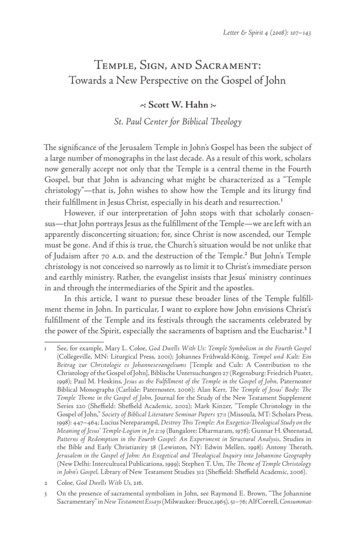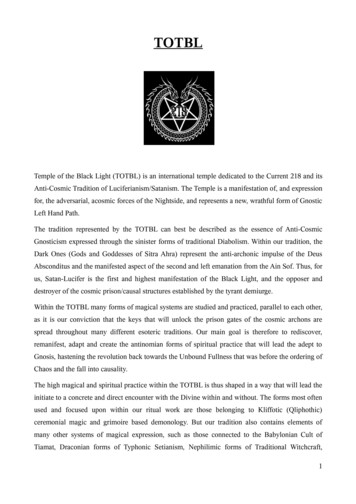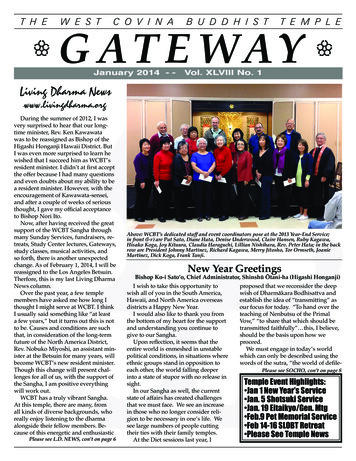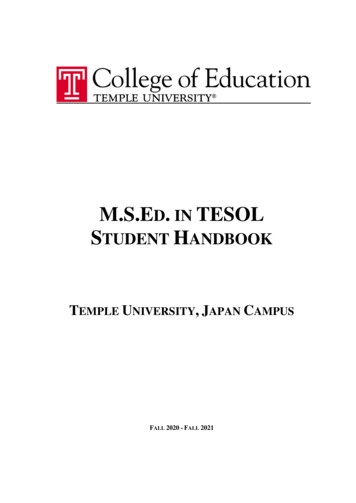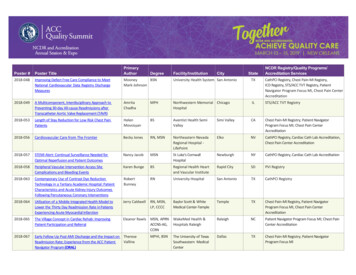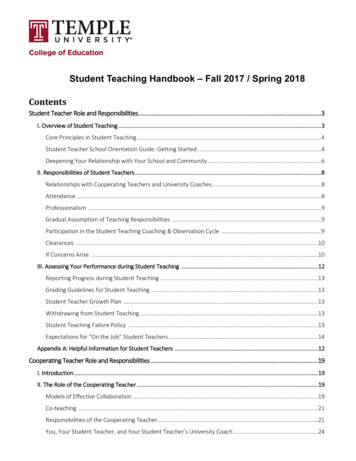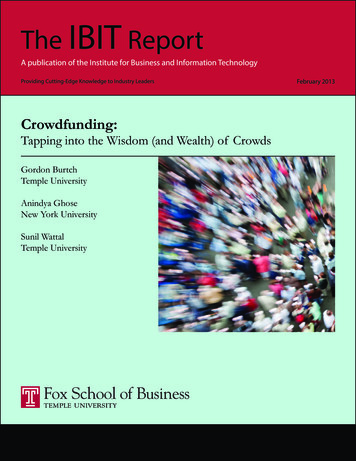
Transcription
The IBIT ReportA publication of the Institute for Business and Information TechnologyProviding Cutting-Edge Knowledge to Industry LeadersCrowdfunding:Tapping into the Wisdom (and Wealth) of CrowdsGordon BurtchTemple UniversityAnindya GhoseNew York UniversitySunil WattalTemple UniversityFebruary 2013
Crowdfunding:Tapping into the Wisdom (and Wealth) of CrowdsGordon BurtchTemple UniversityAnindya GhoseNew York UniversitySunil WattalTemple University February 2013Institute for Business and Information TechnologyFox School of BusinessTemple University
CROWDFUNDINGThe IBIT ReportBruce FademEditor-in-chiefRetired VP and CIO, WyethPaul PavlouEditorProfessor and Stauffer Senior Research FellowFox School of Business, Temple UniversityLaurel MillerManaging EditorDirector, Fox School of Business, Temple UniversityBoard of EditorsAndrea AnaniaRetired VP and CIO, CIGNAEd BeaumontManagement ConsultantMichael BradshawVice President, Lockheed MartinJonathan A. BrassingtonFounding Partner and CEOLiquidHub Inc.Richard CohenManaging Director, DeloitteLarry DignanEditor-in-Chief, ZDnetSmartPlanet Editorial Director, TechRepublicCraig ConwayPresidentConway Technology Consulting, Inc.David KaufmanSenior VP and CIO, AramarkNiraj PatelManaging Director, Witmer, LLCKent SeinfeldRetired CIO, Commerce BankJoseph SpagnolettiSenior VP & CIO, Campbell Soup Co.4The IBIT Report 2013 Institute for Business and Information Technology,Fox School of Business, Temple University, Philadelphia,PA 19122, USA. All rights reserved. ISSN 1938-1271.The IBIT Report is a publication for the members ofthe Fox School’s Institute for Business and InformationTechnology. IBIT reports are written for industry andbased on rigorous academic research and vendor neutralanalysis. For additional reports, please visit our website athttp://ibit.temple.edu.No part of this publication may be reproduced, stored in aretrieval system or transmitted in any for or by any means,electronic, mechanical, photocopying, recording, scanningor otherwise, except as permitted under Sections 107 or108 of the 1976 United States Copyright Act, without theprior written permission of the Publisher. Requests to thePublisher for permission should be addressed to Institutefor Business and Information Technology, Fox Schoolof Business, Temple University, 1810 N. 13th Street,Philadelphia, PA 19122, USA, 215.204.5642, or ibit@temple.edu.Disclaimer: The conclusions and statements of this reportare solely the work of the authors. They do not representthe opinion of Temple University or the members of theFox School’s Institute for Business and InformationalTechnology (IBIT).Review process: IBIT reports are sourced, reviewed, andproduced as follows. The managing editor oversees thisprocess. The editor and editor-in-chief consult on topicsand identify new sources of reports. The editor typicallyworks with authors who are interested in writing reportsand provides feedback on initial drafts. Completed reportsare first screened by the editor-in-chief. After approval thereport is sent out for review to two members of theeditorial board. The editor-in-chief assesses the completedreviews and provides further guidance to authors. Finalreports are then professionally produced and madeavailable to IBIT members.
ForewordThis IBIT Report Crowdfunding: Tapping the Wisdom (and Wealth) of Crowds examines anew application of crowdsourcing focused on the generation of funding for ideas initiated byothers. While news articles and reports on crowdfunding have cited the success of numerous campaigns, the majority of efforts have actually failed. But we believe a thorough understanding of theconcepts of crowdfunding including the design of campaigns and the management of the requiredplatform can result in significant financial and innovation assistance. Our report discusses theseopportunities, benefits, and pitfalls and demonstrates how the crowdfunding marketplace has thepotential to be an innovation hub and improve upon open innovation practices. The report also provides suggestions on how businesses can leverage crowdfunding concepts, how to conduct a crowdfunding campaign, and how to influence contributor behavior.Bruce FademEditor-in-ChiefJanuary 28, 2013ibit.temple.edu5
CROWDFUNDINGIntroductionCrowdsourcing is now a well-established concept– there are many examples of companies that havedrawn on the insights, experience, expertise, creativity, opinions and knowledge of the crowd. Dell’sIdeaStorm allows customers to suggest and vote onideas for product improvements; Threadless’ designcontests encourage customers to submit new t-shirtideas for a chance at prize money; and Wikipedia’smassive network of editors populates and curates anextensive encyclopedic repository, contributing andmaintaining thousands of articles on a daily basis.As these types of examples have grown more prevalent, it has become easier for academics to conductresearch on crowdsourcing. Thus, in the last decade,scholars have expended much time and effort to develop a better understanding of collective processes;how they should be organized and what sorts of tasksthey are best geared toward performing.More recently, however, an interesting new application of crowdsourcing has emerged, termed ‘crowdfunding’. This phenomenon, which has received verylittle academic attention to date, is a particularlynovel form of crowdsourcing. This is because thecrowd is not asked to contribute its creativity or effort. Instead, it is asked to open its wallet, to supportthe ideas and projects of others. In a sense, the crowdis being invited to put its money where its mouth is,and it has responded on a massive scale.A recent industry report indicates that crowdfunding drove nearly 1.5 billion in contributions in2011, and that this number is expected to double in2012. Major media outlets like the New York Timesand the Wall Street Journal have reported on theenormous, seemingly unpredictable success of numerous crowd-funding campaigns. Journalists havecovered everything from entrepreneurial efforts likethe Pebble Watch1, which raised more than 1 million in a little more than a day and ultimately drewover 10 million, to charitable campaigns like theone for bullied bus monitor, Karen Klein, which garnered more than 700,0002. Yet, these success storiesare by no means the norm. Recent academic workhas shown that the bulk of crowdfunding campaignsfail, often miserably (Mollick 2012). It thereforeseems that no one truly has a handle on how thesethings work.Crowdfunding, as an industry, has progressed sorapidly and in so many directions that many business owners remain in the dark about its most basicaspects. As practice and policy continue to moveforward, an understanding of what crowdfundingis, how to conduct a successful campaign, and howto design or manage a crowdfunding platform, is ofparamount importance. Luckily, a number of recentstudies, including our own, have begun to shed lighton these very questions. Here, we summarize themost important findings.1 le-e-paper-watch-for-iphone-and-android2 http://www.indiegogo.com/loveforkarenhklein6The IBIT Report
Figure 1: Crowdfunding TaxonomyWhat is Crowdfunding?Crowdfunding is defined as a collective effortby consumers who network and pool their moneytogether, usually via the Internet, in order to investin and support efforts initiated by other people ororganizations. In crowd-funded marketplaces, anyindividual can propose a project, and anyone else canthen provide funds to support it. Once an individualdecides to provide support, how much or how littleto give is completely at his or her discretion. Depending on the type of crowdfunding platform, acontributor will have different expectations aboutwhat they will receive in return. This is the key difference between the four different types of crowdfunding platforms (Figure 1), which we refer to here as i)donation-based, ii) lending-based, iii) reward-basedand iv) equity-based (Burtch et al. 2013).The concept behind donation- and lendingbased crowdfunding models is relatively self-explanatory. A crowdfunder proffers funds to an entrepreneur with no expectation of anything in return, orwith the expectation of repayment at some later date,respectively. Well-known examples include Kiva.org, founded in 2005, and Prosper.com, founded in2006. While you may question the usefulness of donation-based platforms for business ventures, thinkagain. Donation-based crowdfunding has seen greatsuccess with campaigns or projects that people canidentify with or benefit from (e.g., causes or publicgoods). It can therefore be a great way to engage inprojects intended to further corporate social respon-sibility, goal or purpose of what an organization istrying to achieve, this form of crowdfunding can beextremely successful.The reward-based modelpresents an interesting twist, ascrowdfunders provide funds inexchange for small “perks”.The reward-based model presents an interestingtwist, as crowdfunders provide funds in exchangefor small “perks”. These perks are typically valued inaccordance with the size of the contribution thoughthey vary in form quite a bit. A project organizermight offer units of a proposed product in presale,they might offer swag, or they might offer exclusiveparticipation in focus groups. In essence, the structure of the rewards offered is entirely at the mercy ofthe campaigner’s creativity. These reward-based platforms have only come to the fore in the last couple ofyears, but they have seen massive growth and success.Kickstarter is the poster child for this style of crowdfunding, have facilitated more than 100 millionin project contributions in 2011, and another 300million expected to arrive in 20123.3 ing-growing-explodes-crowdfunding/ibit.temple.edu7
CROWDFUNDINGLast, but certainly not least, equity-based platforms provide individuals with an ownership stake inan entrepreneur’s business, in exchange for contributions. This last flavor of crowdfunding is the leastdeveloped at the moment, as until recently financialregulations around SEC reporting and due diligencemade it extremely impractical to carry out in theUnited States. However, with Obama’s recent signing of the JOBS Act, those rules are set to change.Equity-based crowdfunding is therefore set to takecenter stage in 2013, though it remains to be seenhow much traction this new model will get. This isbecause many ambiguities remain around how theSEC will actually implement the new legislation. Forexample, the legislation stipulates that equity-basedcrowdfunding portals will be barred from providinginvestment advice to individuals, yet it is not clearwhat constitutes “advice” in this sense (e.g., wouldcampaign search and filtering mechanisms violatethis rule?). Additionally, the legislation states thatthe amount of equity a company is allowed to sellto a particular investor will depend on the investor’s annual income or net worth. However, it is notclear how this information will be verified. Will it beenough for an investor to self-report the informationto firm or platform purveyor, or will more rigorouschecks need to be in place? The success of equitybased crowdfunding depends a great deal on howthese legislative components are interpreted.Regardless of how outstanding questions playout, equity-based platforms have already begun tocrop up (e.g., RelayFund.com, PeoplesVC.com,Fundable.com). Across all flavors of crowdfunding,there are now literally hundreds of marketplacesin operation; more than 450 worldwide as of Aprilof 20124. This industry growth reflects the hugeeconomic potential of the crowdfunding conceptand the wide variety of benefits the phenomenon canoffer.4 Based on platforms registered with www.crowdsourcing.org8The IBIT ReportOpportunities, Benefits andPitfalls of CrowdfundingThe crowdfunding model offers an array ofopportunities to entrepreneurs, charitable organizations and even big business. While the number oneadvantage of crowdfunding is clearly that it providesa relatively low-cost approach to raising capital (theprimary reason crowdfunding has gained so muchattention from legislators of late), it has the potentialto offer so much more. In this section, we summarize some of those opportunities, beginning firstwith some of the untapped opportunities for largerorganizations and enterprises, and subsequently discussing the benefits and pitfalls for crowdfunding forcampaign organizers more generally.Open Innovation: Scanning &Monetized Idea-EvaluationThe crowdfunding model presents a number ofopportunities for large enterprises and organizations.It is important to remember that crowdfunded marketplaces effectively act as an innovation hub; thesemarkets are generally inundated with pitches forinnovative ideas, typically issued by a diverse groupof individuals (or small businesses). The success ofthese pitches is a good indicator of an idea’s marketability, not just to the campaign organizer, but also toothers. With that in mind, it would be prudent forlarger, incumbent organizations to monitor relevantcrowdfunding marketplaces to stay abreast of newdevelopments in a given industry. Many industryspecific crowdfunding markets are already beginning to emerge. Some examples of industry-specificcrowdfunding platforms in operation today include:Mosaic, which focuses on solar-energy projects (solarmosaic.com), Sellaband, which focuses on musical artists (sellaband.com), Spot, which focuses onjournalism (spot.us), Mobcaster, which focuses ontelevision programming (mobcaster.com), PropertyPeers, which focuses on Real Estate (propertypeers.com) and Apps Funder, which focuses on mobilesoftware development (appsfunder.com) – and thelist goes on.Crowdfunding also offers an opportunity for theimprovement of open innovation practices. At present, the most successful examples of crowdsourced
Figure 2: My Starbucks Ideaideation marketplaces (e.g., Dell Idea Storm5 or MyStarbucks Idea6) rely on the crowd to propose ideas(see Figure 2, above, for a depiction of My StarbucksIdea). Importantly, however, those ideas are also thensubjected to crowd-based evaluation, via a votingmechanism, to establish demand or popularity. Avote, however, does not entail any potential loss forthe evaluator. As such, rigorous consideration ofthe idea by the voter is not a given, as they have lessreason to be concerned over an idea’s true value orfeasibility.The concepts underlying crowdfunding lendthemselves to improving upon this model. Ratherthan simply voting on ideas, crowdfunders couldbe asked to pledge dollar support behind an idea orinnovation they truly value and would like to seeimplemented. This might be an idea for improvinga product or service, supported by existing customers, for example. Alternatively, one can imagine ascenario in which people support the creation of new5 http://www.ideastorm.com/6 ests (e.g., TopCoder) with personal funds. Theprize amounts awarded for successful implementation of the innovation might then grow in relation tothe market’s desire for that innovation. This application of monetary incentives can facilitate the identification and resolution of the most important customer requests. In fact, in 2010, Innocentive.com,one of the world’s largest innovation contest markets,implemented this very model to identify importantworld issues and to fund innovation contests targetedat resolving them. This concept was implemented inpartnership with Global Giving7.Benefits & Pitfallsof Crowdfunding CampaignsFrom the campaigner’s perspective, crowdfunding allows one to simultaneously tap into thecrowd’s “wisdom” and to garner significant word ofmouth for a new venture or project idea. In short,crowdfunding can help to drive sales early on, whilesimultaneously helping to reduce the costs of new7 back.gspibit.temple.edu9
CROWDFUNDINGproduct development by getting customers involvedvery early on, potentially eliminating costs associatedwith rework.Of course, there is always a flip side to the coin –crowdfunding, if poorly executed, can be the entrepreneur’s bane. Word of mouth and customer feedback can easily become detrimental to new venturesshould they spiral out of control. This is particularlylikely to happen if the expectations of crowdfundersare not met. This can become a problem if projectsare pitched too early, before they are fully formedand well thought out, as campaigners may advertiseunrealistic outcomes or poorly considered deliverables. Mistakes such as these can easily halt a campaign in its tracks. Similarly, if delivery timelines arenot met, if the quality of the deliverable is lacking, ifsupporters are not kept abreast of the project’s progress or if the proposer fails to heed or respond to thecrowd’s suggestions, crowdfunders can quickly turn.Crowdfunding platforms essentially provideprojects and ideas with early exposure to the marketplace. By engaging directly with customers, end-usersor stakeholders who can advocate on the campaignersbehalf, a fundraising campaign that is executed wellcan lead to huge volumes of buzz. Crowdfundingplatforms can also put businesses in direct contactwith potential customers, to tap into their feedbackand input early on in the development lifecycle.Campaigners can establish a rapport with customers at very little cost, to refine plans or designs, toexpand upon them, to assess concept feasibility andto estimate potential value. Thus, entrepreneurs, forexample, can perform an early evaluation of theiridea and changeIt is alsocourse as necessary,important to bearwell before designsin mind that thehave been finalizedcrowd’s responsesor large sums of cashare not alwayshave been sunk intoreflective of thethe venture. Figure 3broader marprovides a graphicalketplace. It is arepresentation of thewell-known facttypical product dethat the crowd isFigure 3: Development Lifecycle & Revenue Realizationvelopment lifecycle,not always wiseand the associatedand that it is oftenincreases in investment/cost over its course. Thisfickle. The crowd’s occasional “stupidity” results fromfigure helps highlight the distinction between crowdvarious systematic errors in judgment and decisionfunding and traditional investment. In short, themaking that can arise within group decision-makinginvestors get involved much earlier and they can actprocesses. Psychologists and behavioral economistsas a sounding board to iron out some of the majorhave been researching and reporting on these effectskinks early on.for years; concepts like pluralistic ignorance, falseconsensus, decision heuristics and biases in judgmentEarly customer interaction also need not be justcan all lead to poor decision-making outcomes8. Asabout drawing on the “wisdom of the crowd” to rea result, the crowd’s input may not always be reliablefine one’s idea. In the case of reward-based platforms, or representative, and thus extremely good or poorthe crowdfunding process can also be leveragedoutcomes in the crowdfunding process should probfor the purposes of presale, allowing businesses toably be looked upon with a healthy dose of skeptidevelop a solid pipeline of purchases before actuallycism. If the crowd’s initial support for a project is notentering into production. A perfect example of thisthe result of well-considered or well-informed delibwas the Pebble Watch project on Kickstarter, notederation, a campaigner may receive a false indicationearlier. This established pipeline of sales could thenthat the market potential is much larger than is trulyfeasibly be leveraged as evidence of market potential,the case, the crowd may easily become dissatisfiedmaking it easier to convince larger investors to signon to the project.8 http://en.wikipedia.org/wiki/list of cognitive biases10The IBIT Report
with project outcomes, and downstream decisions thecampaigner makes based upon these outcomes maybe suboptimal.Intellectual property issues are also important toconsider. If entrepreneurial projects are proposed tooearly, there is the potential that others will capitalizeSupporting this notion, some recent studieson the proposed ideas. Though certain measures dohave noted the crowd’s tendency to occasionally herd exist to prevent this from taking place (e.g., patent,around certain “popular” projects in settings wheretrademark, copyright), they are not without cost.there is the expectation of monetary return (BurtchFurther, the long-term goals of the project also need2011; Zhang and Liu 2012); namely lending- andto be kept in mind when deciding whether to engageequity-based platforms. However, importantly, wein crowdfunding. The involvement of numeroushave found just the opposite in donation-based platcrowdfunders may impede the acquisition of larger,forms (Burtch et al. 2012b). There, we have observed later stage financing, from angel investors or venturecrowding out effects, where contributors shy awaycapitalists, who may prefer to simply avoid potenfrom campaigns that have already received sizeabletial headaches from dealing with tends, hundredssums. This effect serves to countervail any herdingor thousands of other stakeholders. This last notionbehavior that might take place, thus any extreme reshould make clear that a fair amount of due diligencesults that might occur in such markets are more likely should be undertaken before engaging in crowdfundto be legitimate.ing.Table 1. Pros and Cons of Crowdfunding ModelPros Low-cost idea evaluation User Innovation Estimate Market Capacity Facilitate Pre-sales Generate Word-of-MouthThe potential for poor decision-making by thecrowd will be greater in some marketplaces than others, depending on how the process is designed andmanaged. Scholars in the field of collective intelligence have noted a number of factors that can skewor impede the outcomes of crowd decision-making,including social influence (Lorenz et al. 2011), a lackof diversity and a lack of uniformity in contribution(Woolley et al. 2010). In short, the success of a campaign is more likely to be sustainable when contributors’ decisions have been arrived at independently,when the pool of contributors is diverse, and whenthe crowd is uniformly supportive of the idea. Thus,it is important to do your homework before selecting a crowdfunding venue (good platform designcan go a long way to addressing these factors), andit is important to consider who has supported yourcampaign and why, before making any inferences.In fact, some larger campaigners may even wish toimplement their own platform if undertaking a bigcrowdfunding effort.Cons Idea-revelation/IP Difficulty w/ Later Funding Fickle Crowd Potential for Invalid InferenceTable 1, above, summarizes these importantpros and cons of the crowdfunding model, whichwe discuss in more detail below. Of course, once thedecision has been made to enter the fray, the due diligence does not end there. A number of other detailsneed to be considered, in terms of strategizing andplanning for the crowdfunding campaign.Structuring aSuccessful CampaignBeyond the aforementioned variation in the typesof crowdfunded marketplaces, there are also starkdifferences in operating policies. Most crowdfundingplatforms earn their profits by charging project fees,typically between 3% and 9% of the amount raised.Some purveyors, such as Kickstarter, require that thefunding target be met before a fee is charged and anyfunds are paid out, while others, such as IndieGoGo,ibit.temple.edu11
CROWDFUNDINGTABLE 2.The Dos and Don’ts of Campaign SuccessCrowdfunding FactorLonger DescriptionDetailed DescriptionMedia (e.g., Photo, Video)Keep Contributors InformedLeverage Social MediaLofty or Unrealistic TargetsLengthy Funding Durationsdo not. This funding threshold is one of a numberof campaign characteristics that a project proposeris required to specify when submitting their project to the crowdfunding platform. Other examplesof adjustable campaign characteristics include thecampaign duration, description (e.g., the objective,timelines) and rewards offered to contributors. Theseconfigurable aspects of the fundraising campaignare exceedingly important. Our work has identifieda number of significant relationships between theseaspects and the success of a crowdfunding campaign.Excessive fundraising durations have been foundto have a detrimental impact on the likelihood of afundraising goal being met, as these preclude urgency or excitement. Yet, at the same time, longerfunding durations can also lead to greater attentionand awareness in the marketplace, and thus greaterconsumption of the project output in turn. It therefore seems that a careful balance needs to be struckin this regard and that balance will likely dependon the type of venture being considered. For a bigname brand with an established customer following,hype and attention may be the primary goal of thecampaign, whereas a small startup may be primarily concerned with obtaining the funds necessary toremain afloat.Lofty fundraising goals can also have a negativeinfluence on fundraising success because crowdfunders may perceive excessive goals to be unreachable or unrealistic. As many crowdfunding platformsdo not necessitate that the funding process ceasewhen a target is met, setting a lower funding tar12The IBIT ReportInfluence on Success get can be a good strategy, as this does not implythat lower levels of contribution will ultimately beobtained. That being said, “urgency” can again playa role here. When the target threshold is surpassed,contributions may fade, as crowdfunders may perceive that the funding gap has been filled. As such,a reasonable strategy to combat this problem mightalso be to stress in the pitch that the campaign willaddress only a portion of the overall project budget.In terms of positive influences, it should comeas no surprise that social engagement is key. Positive relationships have been found between socialnetwork size and crowdfunding campaign success,broadly supporting the notion that both social media(as an advertising medium) and social capital are important. This is likely the case for two reasons. First,by tapping into social capital, a project proposer canhelp build steam in the funding process, drawingattention to the project and creating buzz. Second, abroader social network can also add credibility andlegitimacy to the fundraiser.Further, as we had alluded to earlier, it doesnot pay to take a campaign to the crowd too early.Beyond issues of intellectual property, it is also quitelikely that the crowd will shy away from projectsthat do not appear polished or ready for prime time.However, project proposers can do a number ofthings to convey such signals of quality: strive to crafta detailed, thoughtful pitch, offer a reasonable arrayof perks or rewards, and set out a clear timeline andbudget specifying how the money will be used (Mollick 2012). These important factors and their effects,discussed above, are summarized in Table 2.
Design and Management ofa Crowdfunded PlatformThe first important step in pursuing a crowdfunding campaign is the choice of platform. Each ofthe crowdfunding models is more or less amenable toa given type of project. A recent industry report suggests that crowdfunding platforms that most closelyresemble financial markets (e.g., equity- and lendingbased platforms) are particularly amenable to crowdfunding for information goods (e.g., games, software,books, music) and these approaches also appear todraw the largest amounts of funding per project. Incontrast, donation- and reward-based crowdfundingappear to be best suited to public good initiatives andpursuits that appeal to individuals’ social identity orideologies9, such as charities, causes, environmentalconservation or community projects.In donation-based platforms, we havefound that crowdfunders’ contributionbehavior parallels that observed incharitable contexts.Of course, it is also feasible for a larger organization that has access to ample resources to host theirown crowdfunding platform for a targeted purpose.Doing so would allow greater flexibility in terms ofmanaging all aspects of the process, though of coursethis would make it impossible to benefit from theexisting user base of a well established platform.There are a number of insights we have gleaned fromour research that can inform the design of a crowdfunding platform. Our work has explored numerousimportant factors, including social influence, cultureand geography.In donation-based platforms, we have found thatcrowdfunders’ contribution behavior parallels thatobserved in charitable contexts (Burtch et al. 2012b).We have found that earlier contributions generally9 position-and-crowdfunding-platforms/14277offset later contributions. This is because crowdfunders believe that their donations are less valuableto the campaign, when they see that much of the gaphas already been filled. The question then, is whatsorts of steps can you take to overcome this problem?Our research suggests a number of opportunities inthis regard.First, one approach that has been found to beeffective in offsetting this “crowding out” effect incharitable settings is the subsidization of individualcontributions (i.e., matching). Strategically doingthis can increase the perceived value of individuals’contributions to the public good. This can thereforeincrease the likelihood of individuals’ contributing,as well as the amount they contribute. Of course, thisapproach is only effective insofar as contributors areaware that subsidization or matching is taking place,thus this strategy needs to be communicated quiteclearly to potential contributors.Second, it seems that crowding out is more like
Tapping into the Wisdom (and Wealth) of Crowds Gordon Burtch Temple University Anindya Ghose New York University Sunil Wattal Temple University. 4 The IBIT Report CRFI The IBIT Report Bruce Fadem Editor-in-chief Retired VP and CIO, Wyeth Paul Pa
